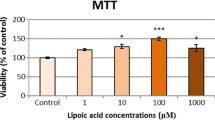Abstract
Ascorbate is a reducing agent, which is also known to oxidize cellular compoentns. Our proposed mechanism of the oxidative action is as follows: Ascorbate is concentrated in the pancreas and is leaked in adverse conditions, and oxidized to dehydroascorbate. The dehydroascorbate is carried into cells by a glucose transporter (GLUT) and reduced back to ascorbate. The reduction processes take electrons from other cellular components. Ascorbate or dehydroascorbate treatment elevated thiobarbituric acid-reactive substance (TBARS) concentrations in pancreas. The elevation in TBARS concentrations were blocked by cytochalasin B, a GLUT inhibitor. To confirm further the prooxidative action, changes in glutathione content were quantified. Glutathione concentrations were lower in ascorbate- or dehydroascorbate-treated groups. The ascorbate-induced decrease in glutathione was blocked by cytochalasin B. To prevent oxidation of ascorbate to dehydroascorbate, glutathione was added to the medium. The ascorbate plus glutathione and dehydroascorbate plus glutathione groups showed lower TBARS concentrations than those of the ascorbate and dehydroascorbate groups, respectively. There were changes in the morphology of Langerhans islets following ascorbate treatment, which disappeared following treatment with ascorbate plus cyto-chalasin B. The observations indicate that ascorbate generates oxidative stress and affects the structure of islets.
Similar content being viewed by others
References
Si, F., Ross, G. M., and Shin, S. H. (1998). Exp. Brain Res. 123, 263–268.
Song, J. H., Shin, S. H., and Ross, G. M. (2001). Brain Res. 895, 66–72.
Song, J. H., Shin, S. H., Wang, W., and Ross, G. M. (2001). Exp. Neurol. 169, 425–437.
Horning, D. (1975). Ann. NY Acad. Sci. 258, 103–118.
Skiz, E. and Guillemin, R. (1963). Endocrinology 72, 804–812.
Cammack, J., Ghasemzadeh, B., and Adams, R. N. (1991). Brain Res. 565, 17–22.
Ngkeekwong, F. C. and Ng, L. L. (1998). Biochem. J. 324, 225–230.
Welch, R. W., Wang, Y. Jr., Crossman, A., Park, J. B., Kirk, K. L., and Levine, M. (1995). J. Biol. Chem. 270, 12,584–12,592.
Vera, J. C., Rivas, C. I., Fischarg, J., and Golde, D. W. (1993). Nature 364, 79–82.
Bode, A. M., Yavarow, C. R., Fry, D. A., and Vargas, T. (1993). Biochem. Biophys. Res. Commun. 191, 1347–1353.
May, J. M., Cobb, C. E., Mendiratta, S., Hill, K. E., and Burk, R. F. (1998). J. Biol. Chem. 273, 23,039–23,045.
Savini, I., D’Angelo, I., Annicchiarico-Petruzzelli, M., Bellincampi, L., Melino, G., and Avigliano, L. (1998). Anticancer Res. 18, 819–822.
Nishikimi, M., Fukuyama, R., Minoshima, S., Shimizu, N., and Yagi, K. (1994). J. Biol. Chem. 269, 13,685–13,688.
Will, J. C. and Byers, T. (1996). Natr. Rev. 54, 193–202.
Jordan, C. D. (1992). N. Engl. J. Med. 327, 718–724.
Spector, R. (1977). N. Engl. J. Med. 296, 1393–1398.
Tsukaguchi, H., Tokui, T., Mackenzie, B., Berger, U. V., Chen, X. Z., Wang, Y., and Brubaker, R. F. (1999). Nature 399, 70–75.
Grunewald, R. A. and Fillenz, M. (1984). Neurochem. Int. 6, 491–500.
Miele, M., Boutelle, M. G., and Fillenz, M. (1994). Neuroscience 62, 87–91.
Rebec, G. V. and Pierce, R. C. (1994). Prog. Neurobiol. 43, 537–565.
Cardinale, G. L. and Udenfriend, S. (1974). Adv. Enzymol. 41, 245–300.
Eyre, D. R. (1980). Science 207, 1315–1322.
Wallerstein, R. O. and Wallerstein, R. O. Jr. (1976). Semin. Hematol. 13, 211–218.
Murad, S., Grove, D., Lindberg, K. A., Reynolds, G., Sivarajah, A., and Pinnell, S. R. (1981). Proc. Natl. Acad. Sci. USA 78, 2879–2882.
Halliwell, B. and Gutteridge, J. M. (1997). J. Neurochem. 69, 1330,1331.
Winterbourn, C. C. (1995). Toxicol. Lett. 82/83, 969–974.
Song, J. H., Harris, M. S., and Shin, S. H. (2001). Neurochem. Res. 26, 407–413.
Song, J. H., Shin, S. H., and Ross, G. M. (1999). J. Neurosci. Res. 58, 328–336.
Walker, J. K., Lawson, B. L., and Jennings, D. B. (1997). Respir. Physiol. 107, 241–250.
Rumsey, S. C., Daruwala, R., Al-Hasani, H., Zarnowski, M. J., Simpson, I. A., and Levine, M. (2000). J. Biol. Chem. 275, 28,246–28,253.
Ramasamy, R., Hwang, Y. C., Whang, J., and Bergmann, S. R. (2001). Am. J. Physiol. Heart Circ. Physiol. 281, H290-H297.
Author information
Authors and Affiliations
Corresponding author
Rights and permissions
About this article
Cite this article
Brown, S., Georgatos, M., Reifel, C. et al. Recycling processes of cellular ascorbate generate oxidative stress in pancreatic tissues in in vitro system. Endocr 18, 91–96 (2002). https://doi.org/10.1385/ENDO:18:1:91
Received:
Revised:
Accepted:
Issue Date:
DOI: https://doi.org/10.1385/ENDO:18:1:91




